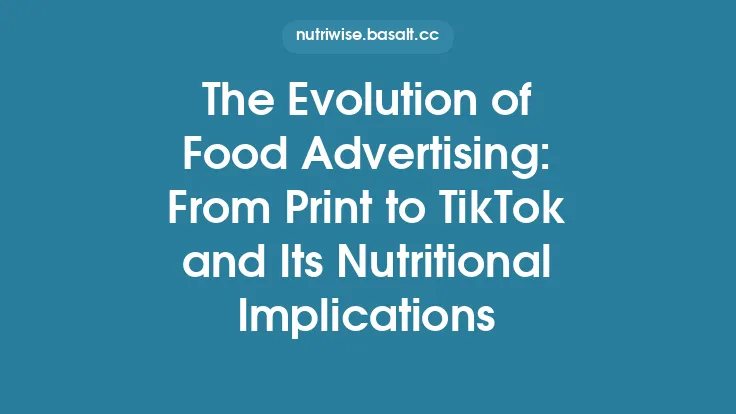Television has been a dominant medium in households for more than six decades, and its role in shaping what people eat and how they think about nutrition is both profound and enduring. Unlike fleeting digital ads or influencer‑driven content, television commercials reach viewers in a shared, often family‑centered environment, creating a collective viewing experience that can reinforce messages through repetition, visual storytelling, and emotional appeal. This article explores the ways television advertising influences food choices and nutrition beliefs, drawing on research from psychology, nutrition science, and media studies to provide an evergreen, evidence‑based perspective.
Historical Context of Television Food Advertising
The first televised food commercial aired in 1941, promoting a brand of soap. Within a few years, food and beverage companies recognized television’s potential to showcase product attributes—color, texture, and taste—in ways print could not. By the 1960s, the “Golden Age” of TV advertising saw the rise of iconic campaigns such as the “Marlboro Man” (though a tobacco ad, its techniques were later adopted by food marketers) and the “Got Milk?” series, which linked milk consumption to strength and vitality.
Key milestones include:
| Decade | Notable Development | Impact on Food Advertising |
|---|---|---|
| 1950s | Introduction of color TV | Enabled vivid depiction of food, increasing appetite appeal |
| 1970s | Emergence of “jingles” | Created memorable auditory cues that reinforced brand recall |
| 1980s | Prime‑time sponsorships (e.g., sports events) | Linked products with aspirational lifestyles |
| 1990s | Infomercials and long‑form ads | Allowed detailed nutritional claims and cooking demonstrations |
| 2000s | High‑definition (HD) broadcasting | Enhanced visual realism, making food appear more appetizing |
These historical shifts illustrate how technological advances have continually amplified the persuasive power of television ads, making them a persistent driver of dietary behavior.
Mechanisms of Influence: Persuasion Techniques
Television advertising leverages a suite of well‑studied persuasion tactics that tap into cognitive, affective, and social processes:
- Visual Appeal and Sensory Imagery
- High‑resolution close‑ups of melting cheese, sizzling grills, or glossy fruit juices trigger the brain’s reward circuitry (dopaminergic pathways), increasing cravings even before the product is tasted.
- Color psychology: Warm colors (red, orange) are associated with increased appetite, while cool colors (blue, green) can suppress hunger; advertisers strategically select palettes to modulate viewer response.
- Narrative Storytelling
- Ads often embed products within relatable family scenes, holiday gatherings, or “quick‑fix” moments, creating a narrative that positions the food as a solution to everyday challenges.
- The “transportation theory” suggests that viewers who become mentally immersed in a story are more likely to adopt the attitudes presented.
- Emotional Appeals
- Nostalgia (e.g., “Remember the taste of Mom’s cookies?”) evokes positive memories, linking the product to comfort and tradition.
- Humor and celebrity endorsement (though the latter is a gray area with the neighboring article, it is still a TV technique) increase ad likability, which correlates with higher purchase intent.
- Authority and Credibility Cues
- Use of “nutritionist‑approved” seals, “clinically proven” statements, or “government‑backed” health claims can lend perceived legitimacy, even when the scientific basis is weak.
- The “source credibility model” indicates that perceived expertise and trustworthiness boost persuasive impact.
- Repetition and Frequency
- The “mere exposure effect” posits that repeated exposure to a stimulus increases preference for it. Television’s scheduled programming allows advertisers to air the same commercial multiple times per week, reinforcing brand familiarity.
- Product Placement and Sponsorship
- Beyond traditional commercials, food brands embed products within TV shows, reality competitions, or cooking segments, subtly influencing viewers without overt advertising. This “soft sell” can be especially effective because it bypasses the audience’s conscious ad‑skepticism.
Target Audiences and Demographic Segmentation
Television networks provide granular audience data through Nielsen ratings and, more recently, set‑top‑box analytics. Advertisers exploit this data to tailor messages to specific demographic groups:
| Demographic | Typical Programming | Advertising Focus | Common Nutritional Claims |
|---|---|---|---|
| Children (2‑12) | Saturday morning cartoons, animated series | Bright colors, mascots, “fun” factor | “Vitamin‑rich,” “calcium‑boosted,” “no artificial colors” |
| Adolescents (13‑18) | Teen dramas, music videos, sports | Trendiness, peer acceptance | “Low‑fat,” “high‑protein,” “energy‑boosting” |
| Young Adults (19‑34) | Reality TV, streaming hybrids, late‑night talk shows | Convenience, lifestyle alignment | “Organic,” “gluten‑free,” “low‑calorie” |
| Families (35‑54) | Prime‑time dramas, cooking shows | Health, value, family bonding | “Heart‑healthy,” “whole‑grain,” “family‑size” |
| Seniors (55+) | News, daytime talk shows, classic movies | Simplicity, digestibility | “Easy‑to‑chew,” “low‑sodium,” “fortified with vitamins” |
By aligning ad content with the values and concerns of each segment, television advertising can shape both immediate purchase decisions and longer‑term nutrition beliefs.
Impact on Food Choices: Consumption Patterns
Empirical research consistently links exposure to television food advertising with measurable changes in dietary intake:
- Short‑Term Effects
A 2015 meta‑analysis of 30 experimental studies found that children who viewed high‑calorie snack ads consumed 23% more of the advertised product within the next hour compared to a control group. Similar effects were observed in adults, though the magnitude was smaller (≈10% increase).
- Long‑Term Effects
Longitudinal cohort studies in the United States and Europe have demonstrated that children who are exposed to ≥ 30 minutes of food advertising per day have a 1.5‑fold higher risk of developing obesity by age 10. In adults, high exposure correlates with increased consumption of sugar‑sweetened beverages and processed meats, contributing to elevated cardiovascular risk scores.
- Brand Loyalty and Habit Formation
Repeated exposure during formative years can cement brand preferences that persist into adulthood. A 2020 study using eye‑tracking technology showed that participants fixated longer on familiar brand logos, even when presented with healthier alternatives, indicating a subconscious bias formed through television exposure.
These findings underscore that television advertising does not merely inform; it actively shapes consumption behavior through both immediate cravings and entrenched habits.
Shaping Nutrition Beliefs and Perceptions
Beyond influencing what people eat, television ads also mold how they think about nutrition:
- Health Halo Effect
When a product is marketed with a single “healthy” attribute (e.g., “low‑fat” or “high‑fiber”), viewers often infer that the entire product is nutritious, even if it contains high levels of sugar or sodium. This cognitive shortcut can lead to overconsumption of ostensibly “healthy” foods.
- Misleading Portion Norms
Commercials frequently depict oversized servings as normal, subtly resetting viewers’ expectations of appropriate portion sizes. Over time, this can contribute to a gradual upward shift in perceived “standard” portion, a phenomenon documented in the “portion distortion” literature.
- Normalization of Processed Foods
By integrating processed snacks and ready‑to‑eat meals into everyday scenarios (e.g., family movie night, after‑school snack), television ads normalize these foods as routine components of a balanced diet, diminishing the perceived need for whole, minimally processed alternatives.
- Reinforcement of Dietary Myths
Certain ads perpetuate outdated or oversimplified nutrition concepts, such as “all‑natural equals safe” or “low‑calorie means weight‑loss ready.” When these messages are repeated across multiple channels, they become part of the cultural lexicon, making it harder for evidence‑based nutrition education to gain traction.
Collectively, these belief‑shaping mechanisms can create a disconnect between scientific nutrition guidance and public perception, influencing policy support, food purchasing decisions, and health outcomes.
Regulatory Landscape and Policy Responses
Governments and industry bodies have implemented a range of measures to curb the influence of television food advertising, especially on vulnerable populations:
- Self‑Regulatory Codes
The U.S. Children’s Food and Beverage Advertising Initiative (CFBAI) encourages participating companies to limit ads for high‑sugar, high‑fat, and high‑sodium products during children’s programming. While compliance has improved, independent audits reveal persistent gaps.
- Statutory Restrictions
The United Kingdom’s Ofcom Broadcasting Code bans the broadcast of foods high in fat, sugar, or salt (HFSS) during programs primarily aimed at children under 16. Similar bans exist in Chile, Norway, and several Canadian provinces, where the timing of HFSS ads is restricted to post‑prime‑time slots.
- Mandatory Front‑of‑Pack Labelling
Some jurisdictions require that any product advertised on television display a clear nutrition label or health warning within the ad itself. This approach aims to provide immediate context, though its effectiveness depends on consumer literacy.
- Public Health Campaigns
Counter‑advertising initiatives, such as the U.S. “Drink Up” campaign or Australia’s “Swap It” series, use the same television platforms to promote water, fruits, and vegetables, attempting to balance commercial messages with public‑health messaging.
Evaluations of these policies suggest modest reductions in exposure to unhealthy food ads, particularly for children, but also highlight the need for comprehensive, cross‑media strategies to address the evolving advertising ecosystem.
Research Methodologies: Measuring Influence
Understanding television advertising’s impact requires robust methodological tools:
- Experimental Designs
- Randomized Controlled Trials (RCTs) where participants view either a set of food ads or neutral content, followed by measurement of immediate food choice or intake.
- Eye‑Tracking Studies to assess visual attention to specific ad elements (e.g., health claims, product images).
- Observational Cohort Studies
- Longitudinal tracking of ad exposure (via diary logs or electronic monitoring) and dietary outcomes over months or years.
- Use of propensity score matching to control for confounding variables such as socioeconomic status.
- Content Analysis
- Systematic coding of ad features (nutrient claims, emotional tone, target audience) across broadcast schedules.
- Application of machine‑learning classifiers to automate detection of health‑related language in large ad libraries.
- Neuroimaging
- Functional MRI (fMRI) studies reveal that exposure to food ads activates brain regions associated with reward (ventral striatum) and decision‑making (prefrontal cortex), providing a biological basis for observed behavioral changes.
These methodological approaches, when combined, offer a comprehensive picture of how television advertising translates into real‑world dietary behavior and belief formation.
Implications for Public Health and Future Directions
The persistent influence of television advertising on food choices and nutrition beliefs carries several implications:
- Policy Integration: Effective regulation should align advertising restrictions with broader nutrition policies, such as taxation of sugary drinks, subsidies for fruits and vegetables, and mandatory front‑of‑pack labeling, to create a cohesive food environment.
- Media Literacy Education: While not the focus of this article, equipping viewers—especially children—with skills to critically evaluate advertising messages can mitigate the “health halo” and other cognitive biases.
- Counter‑Advertising Investment: Public‑health agencies should allocate resources to produce high‑quality, emotionally resonant television campaigns that can compete with commercial ads for viewer attention.
- Technological Adaptation: As television consumption shifts toward streaming platforms with targeted ad capabilities, research must evolve to assess how algorithmic personalization influences exposure and effectiveness.
- Cross‑Disciplinary Collaboration: Nutrition scientists, psychologists, communication scholars, and policymakers need to collaborate on longitudinal studies that track the cumulative impact of television advertising across the lifespan.
By recognizing television advertising as a potent, enduring driver of dietary behavior, stakeholders can design more effective interventions that promote healthier food environments and align public perception with evidence‑based nutrition science.





